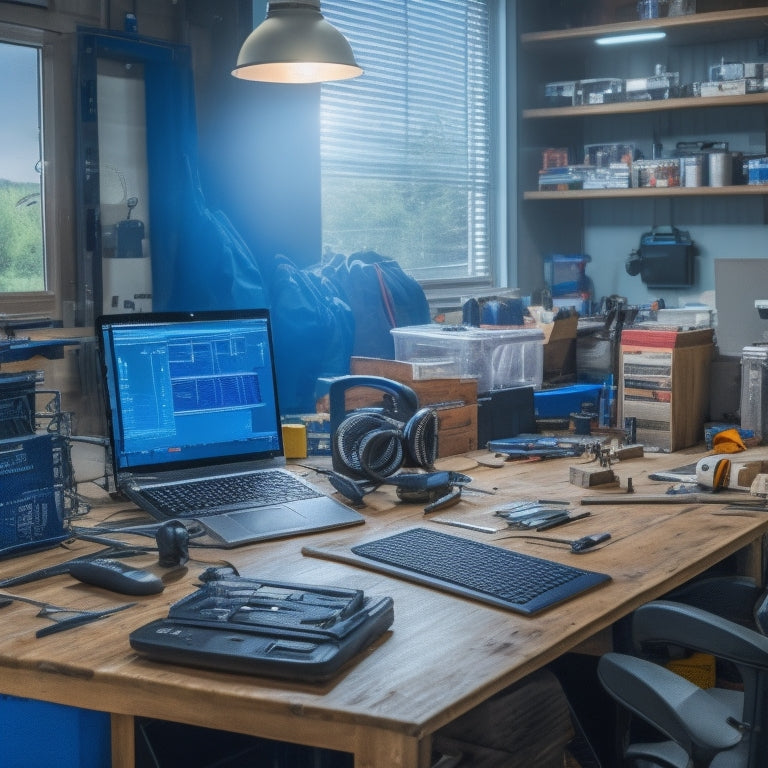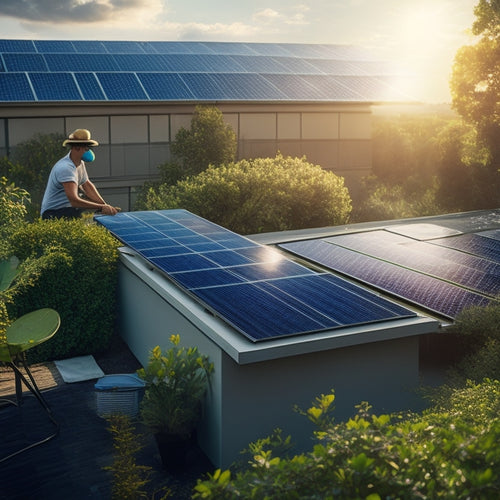
5 Tips for Online Solar Inverter Repair Success
Share
To achieve success in online solar inverter repair, start by choosing reliable services—verify credentials and read reviews for authentic feedback. Confirm the technical expertise of providers by checking certifications and experience with your specific inverter model. Utilize remote diagnostics for real-time monitoring and identifying irregular patterns. Adhere to manufacturer guidelines to maintain warranties and guarantee safe procedures, always using the recommended tools. Schedule regular maintenance, inspecting all components, cleaning filters, and keeping firmware up-to-date. With these steps, you'll handle most inverter issues and be prepared for any challenges that arise.
Key Takeaways
- Verify the service provider's credentials and read customer reviews to ensure reliability.
- Check the technician's certifications and experience with your specific inverter model.
- Use remote diagnostics tools to monitor real-time data and identify issues.
- Follow the manufacturer's guidelines and use recommended tools to maintain warranty and safety.
- Schedule regular maintenance and update firmware to ensure optimal inverter performance.
Choose Reliable Online Services
When selecting reliable online services for solar inverter repair, it's crucial to verify the provider's credentials and read customer reviews to ensure quality and expertise.
Start by examining service reviews on various platforms. These reviews will give you a clear picture of the service provider's reliability and performance. Look for consistent positive feedback and specific mentions of successful repairs. Pay attention to detailed comments about the repair process, timeliness, and customer support.
Next, thoroughly explore user testimonials on the service provider's website. Testimonials can offer insights into customer satisfaction and the overall experience. However, balance these with external reviews to avoid biased opinions. Look for testimonials that highlight the provider's problem-solving skills and technical expertise.
Additionally, check for any recurring issues mentioned in the reviews. If multiple customers report similar problems, it might indicate a systemic issue with the service provider.
Verify Technical Credentials
After evaluating service reviews and testimonials, it's crucial to verify the technical credentials of the online solar inverter repair provider for confirming they possess the necessary expertise. Start by checking their certification verification. Certified technicians have undergone rigorous training and are more likely to fix your solar inverter correctly. Look for credentials from recognized industry bodies, like the North American Board of Certified Energy Practitioners (NABCEP) or equivalent organizations.
Next, assess the credential authenticity. Some providers may list impressive qualifications, but these can be misleading if not verified. Contact the certifying body directly or use their online portals to confirm the technician's credentials. This step ensures you aren't entrusting your solar inverter to someone falsely claiming expertise.
Additionally, inquire about their experience with your specific inverter model. Technicians with relevant experience are more equipped to handle unique issues. Request a detailed explanation of their diagnostic approach to gauge their problem-solving skills.
Utilize Remote Diagnostics
Leveraging remote diagnostics allows you to quickly identify and address issues with your solar inverter without the need for an on-site visit. Real-time monitoring and diagnostic tools are essential for this process. By using these advanced tools, you can gather data on system performance and pinpoint problems as they occur.
Start by connecting your inverter to a reliable monitoring system. Many inverters come equipped with built-in real-time monitoring capabilities or can be paired with external diagnostic tools to track performance metrics. This setup allows you to observe voltage levels, energy output, and error codes from anywhere with an internet connection.
Once connected, regularly check the data provided by your monitoring system. Look for irregular patterns or any deviations from normal operation. Diagnostic tools can help you isolate specific faults, such as a drop in energy output or an unexpected shutdown, enabling you to take immediate corrective action.
Additionally, use the data to perform trend analysis over time. This can help you predict potential issues before they become critical, ensuring the longevity and efficiency of your solar inverter.
Follow Manufacturer Guidelines
Following the manufacturer's guidelines guarantees that your solar inverter operates efficiently and safely. Start by thoroughly reading the user manual provided with your inverter. It contains specific instructions tailored to your model, ensuring you don't miss critical steps. Adhering to these guidelines also helps maintain your warranty policies. Many manufacturers stipulate that deviating from their instructions can void your warranty, leaving you responsible for costly repairs or replacements.
When troubleshooting or repairing your inverter, always use the recommended tools and methods. The user manual often includes troubleshooting sections that guide you through common issues and their solutions. This ensures that you address problems correctly, minimizing the risk of further damage.
Pay close attention to safety warnings and procedures outlined in the user manual. Solar inverters involve high voltages that can be dangerous if handled improperly. By following the manufacturer's safety protocols, you protect yourself and your equipment.
Additionally, always keep your user manual within reach for quick reference. This ensures that you can verify any step or procedure as needed, maintaining the integrity and performance of your solar inverter. Consistently following these guidelines fosters a reliable and long-lasting solar energy system.
Schedule Regular Maintenance
Scheduling regular maintenance is crucial for guaranteeing your solar inverter remains efficient and extends its lifespan. By adhering to a regimen of preventive measures, you can identify potential issues before they escalate into costly repairs. Start by establishing maintenance intervals based on the manufacturer's recommendations, typically every six months to a year.
During these intervals, conduct a thorough inspection of all components. Check for any signs of wear, corrosion, or loose connections. Clean the inverter's cooling fins and filters to prevent overheating. Inspect the wiring for any signs of damage or degradation, as faulty wiring can lead to inverter failure.
Use diagnostic tools to monitor the inverter's performance metrics, such as voltage and current levels. Compare these readings to the manufacturer's specifications to ensure everything is operating within acceptable parameters. If discrepancies are found, address them immediately to avoid further complications.
Additionally, keep your inverter's firmware up-to-date. Manufacturers often release updates that can improve performance and fix known issues. By staying proactive with these preventive measures, you can maximize the efficiency and longevity of your solar inverter, guaranteeing a reliable power supply for years to come.
Frequently Asked Questions
How Do I Troubleshoot Common Solar Inverter Error Codes?
First, refer to your inverter's error documentation for specific codes. Check for any firmware updates that might address the issue. Confirm all connections are secure and reset the system. If unresolved, contact technical support for further assistance.
What Safety Precautions Should I Take When Repairing a Solar Inverter?
Don't jump the gun when repairing a solar inverter. Always wear protective gear and guarantee electrical isolation before you start. Double-check connections and follow manufacturer guidelines to avoid any potential hazards.
Can I Perform Minor Repairs on My Solar Inverter Myself?
You can perform minor repairs on your solar inverter, but consider warranty implications and repair frequency. Regularly fixing the inverter yourself might void the warranty, so always check the terms and assess the repair's complexity first.
How Do I Identify if My Solar Inverter Needs Professional Repair?
You can identify if your solar inverter needs professional repair by checking warranty considerations and observing signs like frequent shutdowns or error codes. Always seek a professional consultation to guarantee accurate diagnosis and avoid voiding the warranty.
What Tools Are Essential for DIY Solar Inverter Repairs?
When it comes to DIY solar inverter repairs, don't put the cart before the horse. You'll need a multimeter for accurate readings and solid soldering skills. These tools will help you troubleshoot and fix issues effectively.
Conclusion
Remember, addressing solar inverter repairs online can be as smooth as silk if you choose reliable services, verify technical credentials, and utilize remote diagnostics.
Always follow manufacturer guidelines and schedule regular maintenance to keep your system running efficiently.
By taking these steps, you'll guarantee your solar inverter remains a powerhouse, driving your renewable energy goals forward.
Attention to detail and proactive problem-solving will make all the difference in your success.
Related Posts
-

Green Ways to Maintain Solar Panels
To maintain your solar panels sustainably, start with regular inspections to catch potential issues early, enhancing ...
-

High-Performance Solar Solutions for Sustainable Living
High-performance solar solutions are your gateway to sustainable living, maximizing energy efficiency while considera...
-

Affordable Solar Panels for Home Use
Affordable solar panels offer you a smart way to cut down on energy costs while promoting sustainability. With govern...


